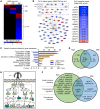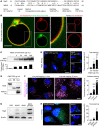Active bacterial modification of the host environment through RNA polymerase II inhibition
- PMID: 33320835
- PMCID: PMC7880420
- DOI: 10.1172/JCI140333
Active bacterial modification of the host environment through RNA polymerase II inhibition
Abstract
Unlike pathogens, which attack the host, commensal bacteria create a state of friendly coexistence. Here, we identified a mechanism of bacterial adaptation to the host niche, where they reside. Asymptomatic carrier strains were shown to inhibit RNA polymerase II (Pol II) in host cells by targeting Ser2 phosphorylation, a step required for productive mRNA elongation. Assisted by a rare, spontaneous loss-of-function mutant from a human carrier, the bacterial NlpD protein was identified as a Pol II inhibitor. After internalization by host cells, NlpD was shown to target constituents of the Pol II phosphorylation complex (RPB1 and PAF1C), attenuating host gene expression. Therapeutic efficacy of a recombinant NlpD protein was demonstrated in a urinary tract infection model, by reduced tissue pathology, accelerated bacterial clearance, and attenuated Pol II-dependent gene expression. The findings suggest an intriguing, evolutionarily conserved mechanism for bacterial modulation of host gene expression, with a remarkable therapeutic potential.
Keywords: Immunotherapy; Inflammation; Microbiology; Transcription.
Conflict of interest statement
Figures









Comment in
-
Collateral effects of deletion of nlpD on rpoS and rpoS-dependent genes.J Clin Invest. 2021 Sep 15;131(18):e152693. doi: 10.1172/JCI152693. J Clin Invest. 2021. PMID: 34523610 Free PMC article. No abstract available.
-
Collateral effects of deletion of nlpD on rpoS and rpoS-dependent genes. Reply.J Clin Invest. 2021 Sep 15;131(18):e153234. doi: 10.1172/JCI153234. J Clin Invest. 2021. PMID: 34523612 Free PMC article. No abstract available.
Similar articles
-
Bacterial control of host gene expression through RNA polymerase II.J Clin Invest. 2013 Jun;123(6):2366-79. doi: 10.1172/JCI66451. J Clin Invest. 2013. PMID: 23728172 Free PMC article.
-
Bacterial Suppression of RNA Polymerase II-Dependent Host Gene Expression.Pathogens. 2016 Jul 13;5(3):49. doi: 10.3390/pathogens5030049. Pathogens. 2016. PMID: 27420101 Free PMC article.
-
The role of the bacterial protease Prc in the uropathogenesis of extraintestinal pathogenic Escherichia coli.J Biomed Sci. 2020 Jan 3;27(1):14. doi: 10.1186/s12929-019-0605-y. J Biomed Sci. 2020. PMID: 31900139 Free PMC article.
-
The bacteria and the host: a story of purinergic signaling in urinary tract infections.Am J Physiol Cell Physiol. 2021 Jul 1;321(1):C134-C146. doi: 10.1152/ajpcell.00054.2021. Epub 2021 May 12. Am J Physiol Cell Physiol. 2021. PMID: 33979212 Review.
-
TLR- and CXCR1-dependent innate immunity: insights into the genetics of urinary tract infections.Eur J Clin Invest. 2008 Oct;38 Suppl 2:12-20. doi: 10.1111/j.1365-2362.2008.02004.x. Eur J Clin Invest. 2008. PMID: 18826477 Review.
Cited by
-
Immunomodulation therapy offers new molecular strategies to treat UTI.Nat Rev Urol. 2022 Jul;19(7):419-437. doi: 10.1038/s41585-022-00602-4. Epub 2022 Jun 22. Nat Rev Urol. 2022. PMID: 35732832 Free PMC article. Review.
-
Collateral effects of deletion of nlpD on rpoS and rpoS-dependent genes.J Clin Invest. 2021 Sep 15;131(18):e152693. doi: 10.1172/JCI152693. J Clin Invest. 2021. PMID: 34523610 Free PMC article. No abstract available.
-
Polyvalent Bacterial Lysate with Potential Use to Treatment and Control of Recurrent Urinary Tract Infections.Int J Mol Sci. 2024 Jun 3;25(11):6157. doi: 10.3390/ijms25116157. Int J Mol Sci. 2024. PMID: 38892345 Free PMC article.
-
Collateral effects of deletion of nlpD on rpoS and rpoS-dependent genes. Reply.J Clin Invest. 2021 Sep 15;131(18):e153234. doi: 10.1172/JCI153234. J Clin Invest. 2021. PMID: 34523612 Free PMC article. No abstract available.
-
Molecular determinants of disease severity in urinary tract infection.Nat Rev Urol. 2021 Aug;18(8):468-486. doi: 10.1038/s41585-021-00477-x. Epub 2021 Jun 15. Nat Rev Urol. 2021. PMID: 34131331 Free PMC article. Review.
References
Publication types
MeSH terms
Substances
LinkOut - more resources
Full Text Sources
Other Literature Sources
Medical
Molecular Biology Databases

